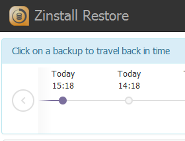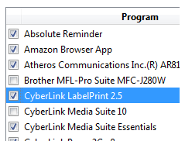You know that you should backup your entire computer. For many of us, a sudden computer crash (and they are always sudden) would mean a serious setback. When was my last backup? Where is it stored? Is it up to date? And even if no files are lost, how long will it take to restore everything to a new computer, reinstall all programs, reconfigure accounts and settings, put all of the files where they are supposed to go – and just generally get back to work?
This guide has a simple goal: to ensure that you have a full backup of your entire computer, that it is up to date, and that you can restore everything from it when disaster does happen.
We will cover:
Just want the instructions on how to backup your entire computer? Click here to skip to that part
First, let’s define that a “full” or “entire” backup actually means. A common misconception is that if all of your documents and photos are backed up, you are all set.
A backup of all of your documents is of course much, much better than no backup. However, it is often not enough.
What about your emails? Favorites? Accounts and passwords?
What about the data from your tax software? Reports from your accounting apps?
What about the actual programs that you use?
Again, having a file backup is great, and is a giant step in the right direction. It’s just that there is much to your computer than just files, and without that – it won’t feel like “home”.
A backup of your entire computer should thus include:
OK, so we know what should go into a full backup. Now, where do we store all of that stuff?
A full backup of your entire computer is going to take up quite a bit of space, so you probably won’t be able to fit it on a small USB stick. Here are some better alternatives:
A USB external drive is essentially a small box that connects to your computer. These drives have lots of room, and are the cheapest option available for backup storage. They are available at Walmart, on Amazon, or at any computer or electronics store.
See instructions on how to very easily backup your entire computer to USB external drive below.
This is similar to using a USB drive, only in this case, the drive is not connected directly to the computer – it is connected to your internet router, and the computer “talks” to via your home network. Network drives are a bit more expensive than regular USB drives, and require a few more steps to set them up. The advantage is that you do not have to physically connect anything to your computer, and can even backup several computers to one network drive. For a dedicated guide on backup to a network drive, see here: How to backup your entire computer to Network Drive / NAS
Another popular option is to upload your backup to Cloud storage. This essentially means that instead of storing your backup on your own drive, you store it on a server belonging to a Cloud storage provider. The advantage of using Cloud is its “survivability”: your backup will be there even if all of your drives fail at the same time, such as during a natural disaster (flood, fire, etc.).
The downsides of using Cloud are its cost (it typically costs ~$100 per year), and slow speed (it takes much, much longer to upload data to the Cloud than to store it on a local drive).
Here are some popular Cloud storage options and backup guides for them:
OK. We now know what we want to backup, and we know where we can store that backup. Let’s see how to actually set this up.
There many ways to perform a backup of your computer. You can do this manually, or using free tools that create a single backup (such as the Backup and Restore tool that is included in Windows 11 and Windows 10). However, that would not be automatic, which means that it gets outdated the moment it is done (after all, most of us won’t have the time and patience to keep manually running backups every day). Additionally, a simply backup like that won’t be able to restore your programs or settings to a different computer – just the files. We are going to use something a bit more powerful.
The product we will be using here is Zinstall FullBack Pro. It creates a full backup of your entire computer. It keeps that backup up to date, hourly. It can backup to USB drive, network drive or to Cloud. And it can restore everything, even programs.
Here is how to use it backup your entire computer to USB drive or another location:
It really is that simple to keep your entire computer safe.
Click here to get a free trial, and make a full backup of your entire computer
Once FullBack starts to run, it performs a complete backup of your entire computer, including programs, settings, accounts, profiles, email, favorites, documents, photos, and all files.
Once that backup is complete, FullBack keeps it up to date, by backing up any changes made to your computer. To save storage space, those backups are incremental, i.e. only the actual changes are stored in your backup – without unnecessary data.
You do not need to manage backup schedules and do not need to remember to make a backup (who can remember this stuff?). It’s all automatic, and always up to date.
Of course, the real reason you have a backup is the restore part. How do you restore a single file that you’ve misplaced? And how do you restore everything, including program files, if your computer crashes? Read on to find out.
So you were working on an important document, and now it’s gone. Fear not – that’s exactly why you have set up an automatic backup of your entire Windows 11 or Windows 10! Here is what you do:

That’s it – your file is back, safe and sound.
This is something you can only do if you have used Zinstall FullBack. It can actually restore all the stuff from your backed up computer (programs, settings, files, emails, accounts, password, favorites, documents, pictures, music, etc.) onto a completely different computer and completely different Windows. Even if you’ve backed up a Windows 10 32bit Dell, and your replacement PC is a Windows 11 64bit HP, Zinstall will still restore everything you’ve got.

To do that, install Zinstall FullBack on the replacement computer. Open your original backup, and follow the prompts for complete restore. When finished, just restart the computer, and you’ll see all the programs, settings and files from your crashed computer.
If you want to go for an even more comprehensive protection, a good rule to follow is the 3-2-1 rule of backups: always have 3 copies of your data, stored in 2 locations, 1 of them off-site.
These days, this extra safe approach means having a local backup (e.g. to backup your entire computer to a USB hard drive) and a Cloud backup (e.g. backup your entire computer to one of the Cloud options) – and keep both up to date. Luckily, FullBack Pro allows you to comply with the 3-2-1 rule by adding another backup target, independent of your original backup.
This way, you can keep two separate backups of your computer – one local, and one on the Cloud. In total, you have 3 copies of your data (computer itself, local drive, Cloud), in 2 locations (your home / office and the Cloud), 1 of them off-site (in your Cloud storage).
Another important benefit of using this kind of hybrid backup approach (local + Cloud) is speed. In most recovery scenarios, your local backup is alive and well (as opposed to situations when you must have an off-site location, such as fires, floods etc.) It is much faster to restore from local storage than from the Cloud; having a local backup will allow you to be even more efficient in your restores, without sacrificing the resilience you get with off-site Cloud backup.
Knowing that you need a full backup of your entire computer is the first step towards keeping your stuff safe. A simple file backup is better than no backup; a one-time backup is better than no backup. For true safety and protection, however, you must have an automatic, up to date backup that can restore everything you need.
We believe that the approach outlined in this guide provides the optimal combination of a easy setup (no technical skills required), and an exceptional backup performance and reliability.
You can literally set up a full backup of your entire computer in 5 minutes, and basically forget about it after that.
The next time you’ll have to think about your backup is when you lose a file, or when your computer crashes. When that happens, you’ll thank yourself for spending those 5 minutes on getting a great backup for your computer.